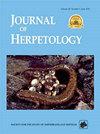Vocal Repertoire of Two Bokermannohyla (Anura: Hylidae) Species, with an Overview of Advertisement Call Diversity in the Genus
IF 0.8
4区 生物学
Q3 ZOOLOGY
引用次数: 0
Abstract
Abstract. Bokermannohyla treefrogs produce a rich array of acoustic signals in their vocal repertoires. Here we report and describe for the first time the vocalizations of B. caramaschii, a species lacking vocal slits. We also extend the known vocal repertoire of B. gouveai by describing a previously unreported note type and revisiting intraspecific variation based on an increased sample of recorded males. The advertisement call of both species is composed of two types of multipulsed notes with emphasized sound energy at low frequencies (<1 kHz). We discuss the possible implications of lack of vocal slits for production of vocal sounds by B. caramaschii. Furthermore, we address inconsistencies in the previous call description of B. gouveai and reassess the species' acoustic variation based on an increased sample size of topotypes. Lastly, we provide the first overview of the advertisement call diversity within Bokermannohyla, recognizing major temporal patterns of their calls.两种Bokermannohyla(无尾目:Hylidae)的声乐汇辑及其属内广告语多样性综述
摘要Bokermannohyla树蛙在它们的声乐曲目中产生了丰富的声学信号。在这里,我们首次报道和描述了B.caramaschii的发声,这是一个缺乏发声狭缝的物种。我们还通过描述一种以前未报告的音符类型,并在记录的雄性样本增加的基础上重新审视种内变异,扩展了已知的高维艾声乐曲目。这两个物种的广告叫声由两种类型的多脉冲音符组成,在低频(<1 kHz)下具有强调的声能。我们讨论了缺乏声道狭缝对B.caramaschii产生人声的可能影响。此外,我们还解决了之前对小牛肉的调用描述中的不一致之处,并根据地形类型样本量的增加重新评估了该物种的声学变化。最后,我们首次概述了Bokermannohyla内部的广告呼叫多样性,识别了他们呼叫的主要时间模式。
本文章由计算机程序翻译,如有差异,请以英文原文为准。
求助全文
约1分钟内获得全文
求助全文
来源期刊

Journal of Herpetology
生物-动物学
CiteScore
1.60
自引率
0.00%
发文量
45
审稿时长
6 months
期刊介绍:
The Journal of Herpetology accepts manuscripts on all aspects on the biology of amphibians and reptiles including their behavior, conservation, ecology, morphology, physiology, and systematics, as well as herpetological education. We encourage authors to submit manuscripts that are data-driven and rigorous tests of hypotheses, or provide thorough descriptions of novel taxa (living or fossil). Topics may address theoretical issues in a thoughtful, quantitative way. Reviews and policy papers that provide new insight on the herpetological sciences are also welcome, but they must be more than simple literature reviews. These papers must have a central focus that propose a new argument for understanding a concept or a new approach for answering a question or solving a problem. Focus sections that combine papers on related topics are normally determined by the Editors. Publication in the Long-Term Perspectives section is by invitation only. Papers on captive breeding, new techniques or sampling methods, anecdotal or isolated natural history observations, geographic range extensions, and essays should be submitted to our sister journal, Herpetological Review.
 求助内容:
求助内容: 应助结果提醒方式:
应助结果提醒方式:


